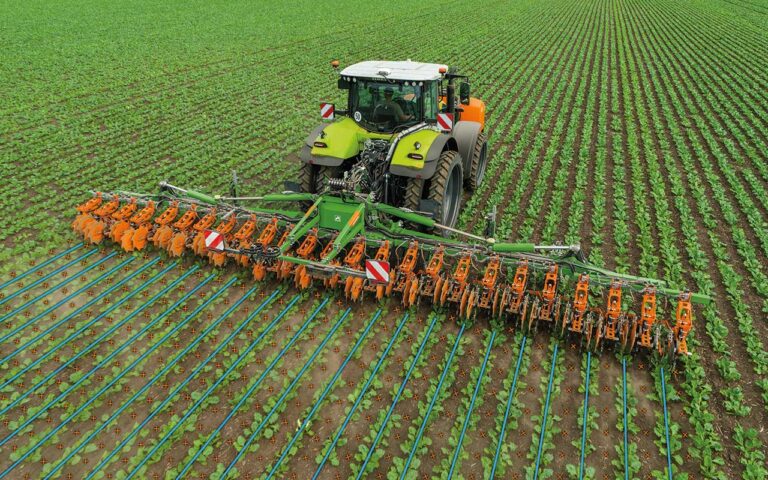Greater scrutiny of how food is produced is present at every level these days. Consumers are more aware than ever of what goes into their food, governments are looking for any way to reduce the environmental impact of operations, and retailers are balancing all of these pressures.
When retailers take note, growers have to as well. Add to these concerns the increasing resistance levels found in certain weeds and the removal of key actives, and it is no surprise that non-chemical alternatives are seen as a growing market in the UK.
This will come as no surprise to vegetable growers, or organic growers, for that matter, who have long used mechanical systems to keep weed pressure in check. However, cereal growers and those starting on a regenerative agriculture journey may be surprised at the depth of the market.
Not just that, but we are now seeing greater versatility from these machines, from increased camera accuracy, to the ability to apply seeds, fertiliser or even the odd chemical, to novel, non-mechanical methods of weed destruction.
Amazone
The Amazone Venterra range of inter-row cultivators hit the market in 2023 after the acquisition of the Schmotzer brand in 2019.
This year the Venterra 2K, which comes in working widths of 4.5-6.75m, has been joined by its wider and narrower variants, the Venterra 1K and VR 4. They are available in working widths of 1.3-4.2m and 7.2-12.8m, respectively.
All models have working speeds of up to 15kph and have flexible row spacing options down to 12.5cm.
Each parallelogram is individually suspended so it guides the hoeing tools precisely between the crop rows. Machines consist of hoe blades to control weeds, while protection discs prevent small crop plants from being buried.
The finger hoes in turn remove weeds from the base of the row, while the following comb harrow lifts the weeds and removes soil from the roots.
Parallelograms with frame clearances of up to 100cm are available for tackling hoeing between taller crops such as maize later in the season.
The hoeing units can be hydraulically lifted and lowered individually via the automatic part-width section control. In tapered fields, this allows hoeing right into the corner of each row on the headland without damaging a single plant.
Amazone also offers both the Smart Vision in-house solution and the Horus camera system. The hoes have the option for one or two cameras to be fitted.
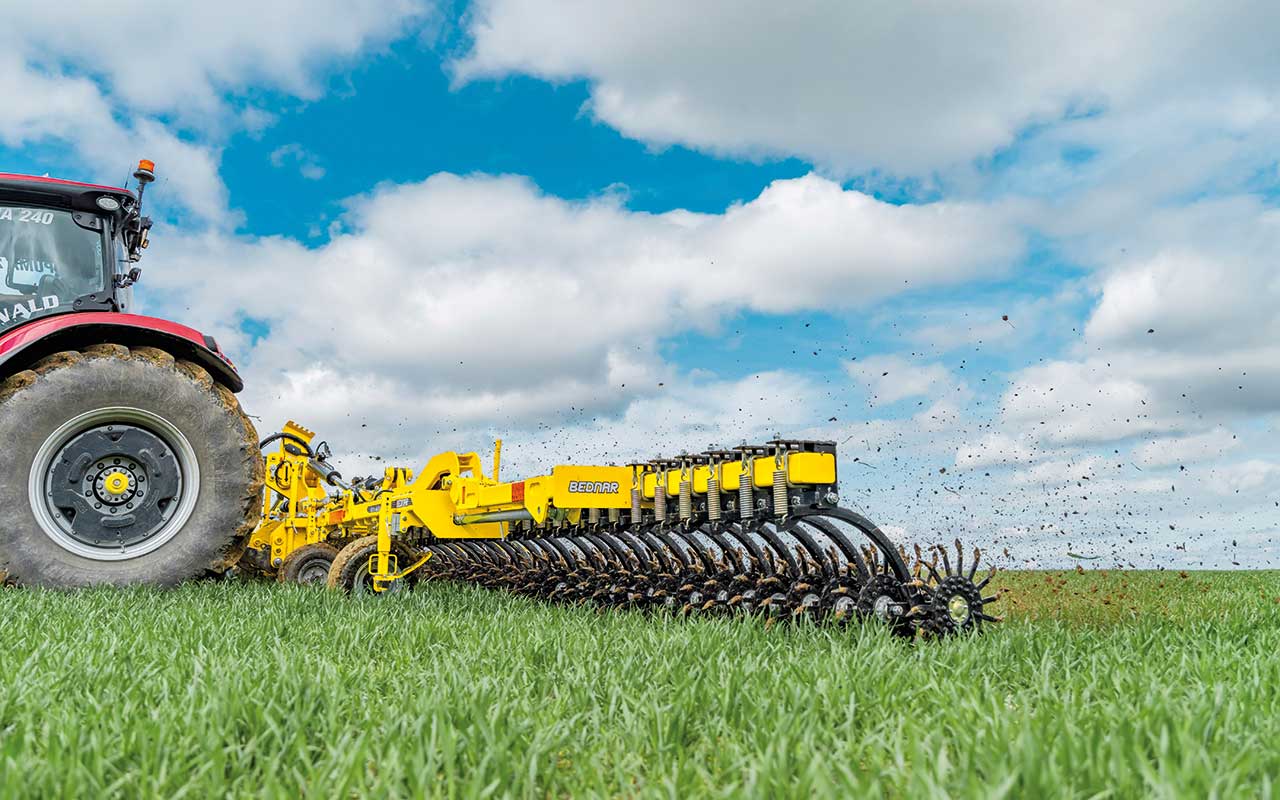
Bednar
Bednar’s mechanical weeding portfolio comprises the Row-Master RN Profi and the Roto-Master RMN.
The Row-Master is an inter-row cultivator available in working widths from 4.8m up to 9.6m, with a high frame clearance of 90cm to enable working late into the growing stages.
It can be linked to the company’s front hopper to establish catch crops in one pass, and can be specified with the Culticam system; a Tillet and Hague camera set-up that guides the individual working elements to ensure good weed destruction and minimise crop damage.
Each cultivation unit is mounted on a parallel linkage, enabling individual row control for headland lifting, or in
awkwardly shaped fields.
Designed to work at up to 30kph, Bednar’s Roto-Master is a rotary hoe designed to destroy young weeds and break up the soil crust.
It features hydraulically adjustable support wheels to suit different track widths, as well as the possibility to change row spacings between 50cm and 80cm to suit the crop.
Working widths are 6m, 9m or 12.4m, with each arm mounted with two 480mm-diameter star wheels. These wheels are offset against each other, said to improve the throughput of the machine and the contour-following capabilities.
The working depth is between 2cm and 4cm, with the possibility to increase the downward pressure to 30kg/wheel.
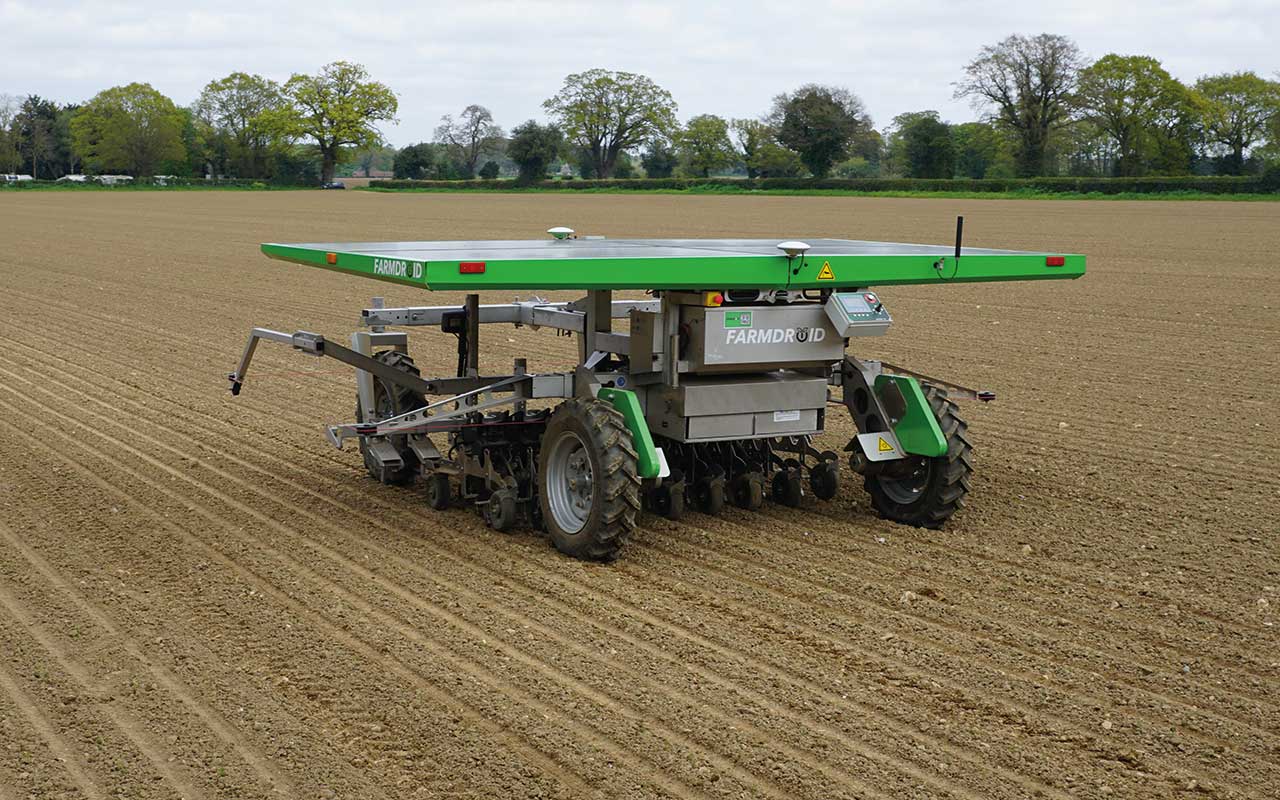
FarmDroid
Distributed by Opico, the FarmDroid is a fully autonomous, solar-powered robot capable of precision drilling, weeding and now spraying. Originally the ‘seed ‘n weed’ robot, it uses ultra-accurate GPS to record exactly where it places each seed.
Then, on each subsequent weeding pass, it has no need to identify what is a weed and what is not – it simply knows where the individual plants should be and works around them.
The fixed hoe shares run between the rows and the moving blades remove anything in the row between each individual plant.
With intra-row and inter-row action, it eliminates weeds both between the rows and between the individual plants.
Capable of working right up to within 5mm of each seedling between the rows and 20mm in the row, the shares mean it produces a complete weeding job, so there is no need for hand-rogueing problem weeds like fat-hen.
One FarmDroid can manage 20ha, but if optioned with an additional power bank, this area can be doubled to 40ha, depending on crop.
Introduced as a three-wheeled machine, the FarmDroid is now available with either three or four wheels, with pairs of wheels running in the same tracks front and rear.
It can also be fitted with a spot-spraying application system for either intra-row or inter-row applications of pesticides and micronutrients. It provides targeted doses, rather than broad-brush, blanket coverage.
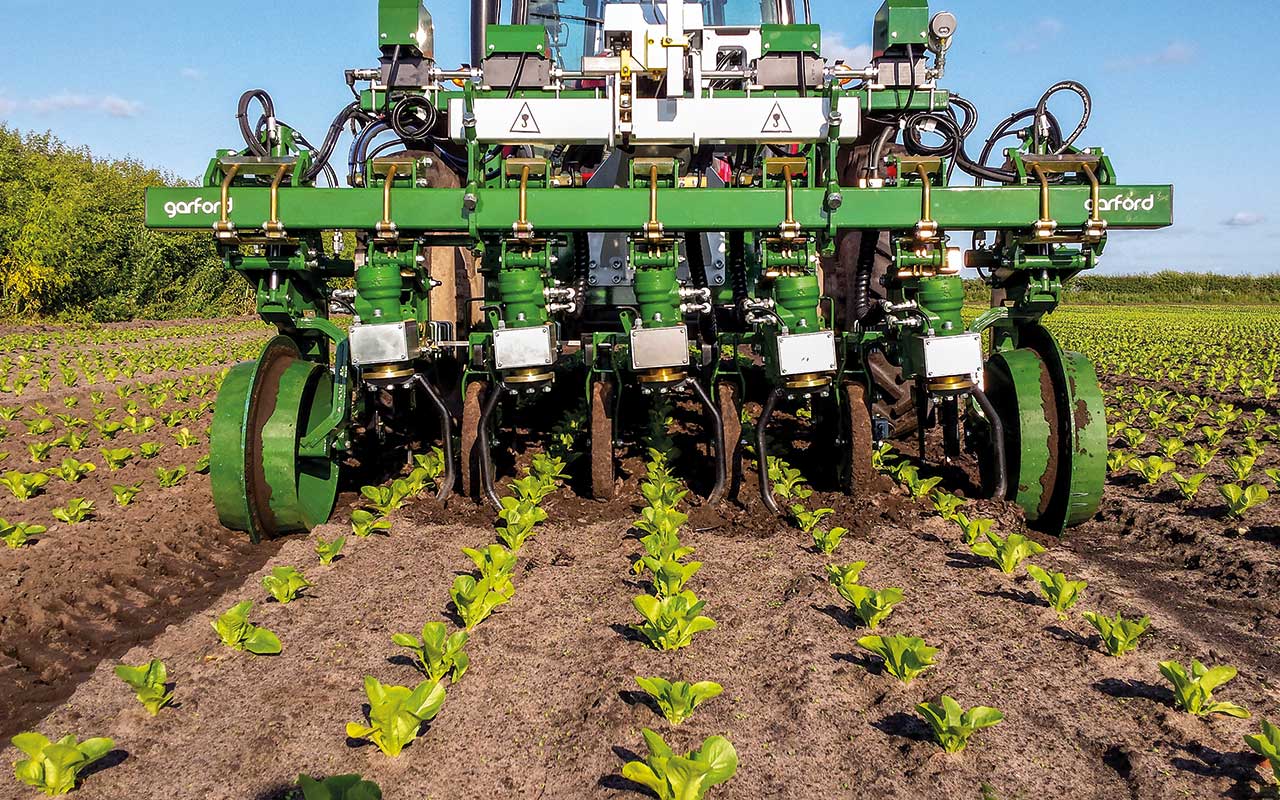
Garford Farm Machinery
Garford is one of the longest-serving manufacturers of mechanical weeding technology in the UK, specialising in bespoke-built, camera-guided hoes.
The most recent addition to the range is an electric weeder, developed alongside Rootwave and combining electrical current technology with Garford’s camera-based guidance system.
According to Garford, this not only has environmental benefits, but also works out significantly cheaper than using pesticides, while ensuring a higher kill rate.
The company has worked to update its software, with the new Robocrop artificial intelligence (AI) enabling green-on-green recognition to allow mechanical hoeing elements to work closer to the cash crop.
According to the company, a big benefit of Robocrop AI, differentiating it from other systems, is the multi-modal camera set-up.
By using infrared cameras as well as a colour camera, depth imaging, calculating vegetative index and then using data fusion techniques, the system accurately detects stem locations, even where multiple leaves overlap.
Feeds from the cameras are run through an AI network, which is trained to recognise the crop plant and stem location, and distinguish these from weeds and non-crop plants based on colour, leaf shape and profile. It comes with a 10.1in terminal with a newly developed interface, with livestreamed images and sideshift positioning.
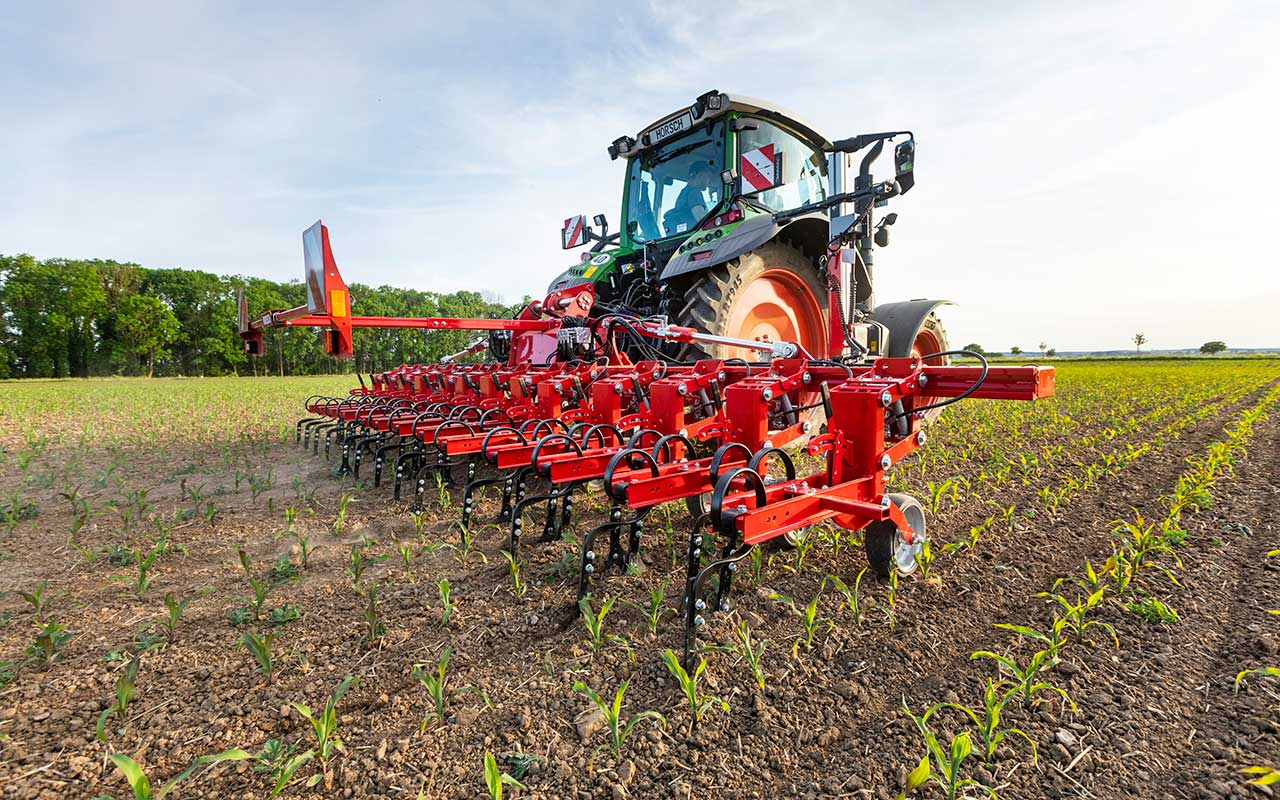
Horsch
The Transformer VS (Variable Small) is a new hoeing tool available in 6m, 9m and 12m working widths. The design of the hoeing unit allows for row spacings of 25cm and 30cm.
Joining the larger VF model, Transformer VS has a compact design that includes the main frame, the fully integrated lateral slide unit and a slide range of 450mm.
The lighter, compact design allows it to be used with smaller tractors and offers precise terrain following.
Soil adaption is improved by having one depth control wheel per hoeing unit and point. The short distance from the point to the control wheel enables the hoeing unit to adapt to the terrain more easily.
The proven camera equipment from the Transformer VF provides switching between colour-dependent 2D row recognition and colour-independent 3D row recognition.
The result is a wide range of applications where the system recognises small plants starting at 2cm.
The Cura 18 ST features an 18.2m working width, allowing it to fit perfectly into a 36m tramline system.
Joining the 15m and 24m models, the Cura ST offers a high hectare output, high stability and a robust, torsion-resistant design which is the result of the closed, square tube frame design.
The 450mm frame height enables harrowing of high crops and makes the Cura ST a key machine for hybrid as well as for organic farming.
The 28mm spaced and 8mm thick tines of the Cura ST are individually fastened and spring-loaded with a pressure can be adapted from 300g to more than 5kg.
This allows for various applications ranging from blind harrowing to breaking crusts or keeping the fields “black”.
The angle of the tines can be adjusted via the hydraulically height adjustable support wheels. In the field, the angled side wings are used in a floating position to guarantee a good soil adaption of every single part of the frame.
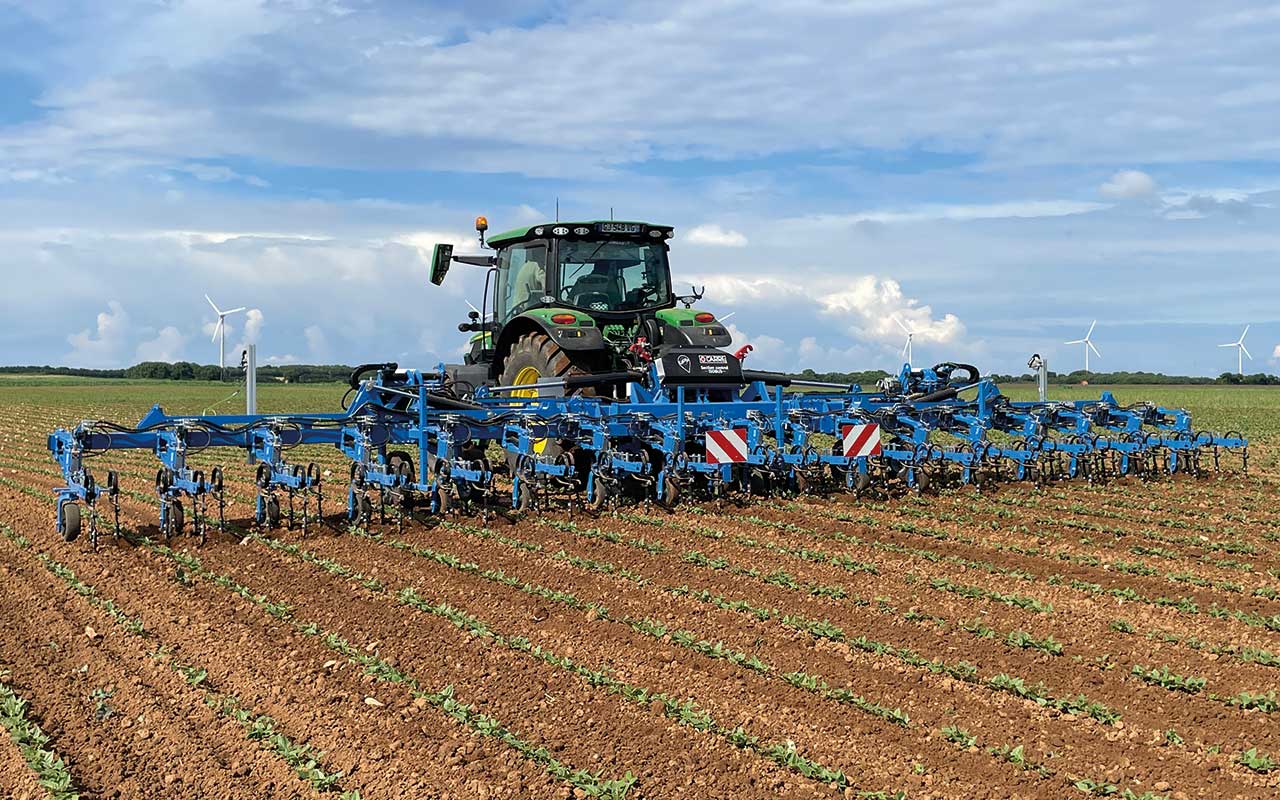
KRM
For many years, hoeing has been common practice in vegetable and sugar beet production, but KRM is finding a growing market in the arable sector. This is why it introduced the Carre-built Klinea, designed for hoeing cereal crops.
As a result of demand for a wide, high-output machine, KRM and Carre have daeveloped the Klinea Duo.
It incorporates two hoeing sections, each with camera and guidance systems, enabling two drill bouts to be hoed in a single pass. For example, in a 12m Duo there are two 6m hoeing elements.
The Duo features parallelogram-mounted hoeing elements, fitted with laterally rigid tines to prevent the share from deviating. A double row of combs at the rear of the hoeing element ensures that weed roots are left exposed on the soil surface.
The Kipline camera system, along with the Weed Pilot in-cab display, manages both cameras and both hoeing sections.
The system can operate in a fully automatic mode for most situations or in expert mode for more challenging conditions, such as where there is a heavy weed burden, or where weeds are similar in colour and size to the growing crop.
GPS-controlled hydraulic lifting of each element is an increasingly popular option, allowing the tines to automatically raise out of work at the headland.
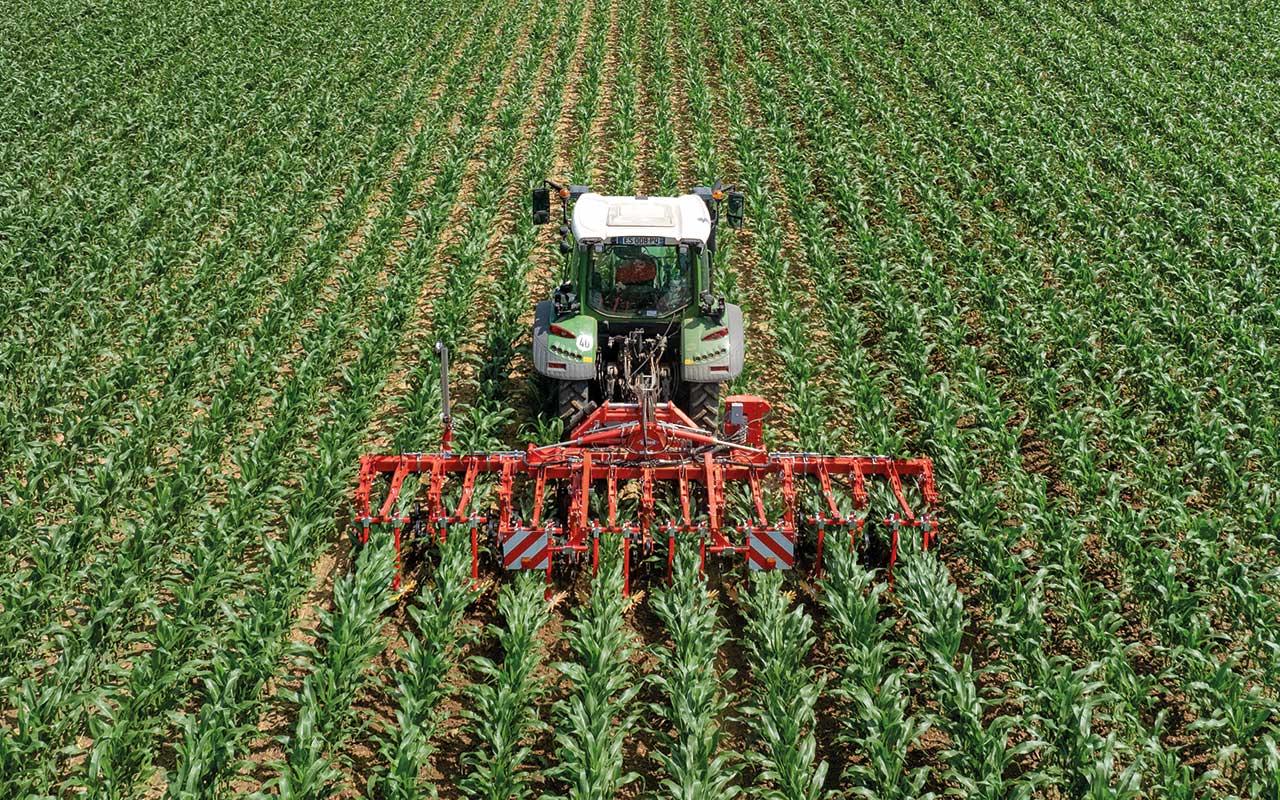
Kuhn Farm Machinery
Kuhn offers three mechanical weeders suited to different cropping, soil types and weeding. Launched in 2023, the Rowliner and Tineliner were joined by the Starliner in 2025.
The Tineliner is designed to work in young cereal crops as soon as weeds emerge or before they appear. Available in 6m, 9m or 12m, it is made up of 1.5m sections with independent hydraulic adjustment to ensure uniform weeding and consistent tine pressure.
Each 1.5m section has 48 tines, spaced 3.125cm apart, for accurate weeding and no disturbance to the planted crop.
For row-crop weeding, the Rowliner is available with either six or eight rows with a 750/800mm spacing (160mm duck-foot share), or a 12-row machine with 450/500mm spacings (180mm duck-foot share).
Each weeding unit has its own parallelogram linkage for improved ground following and up to 120kg of pressure per unit, allowing high work rates.
Different shares, deflectors and weeding options can adapt the machine to the crop’s growth stages, while all models feature a 700mm under-frame clearance for working up to the point of row closure.
A Rowlink camera guidance side-shift linkage allows up to 500mm of sideways adjustment and uses the cameras to detect gaps between rows and control the interface to avoid crop damage.
Section control through Isobus, or individual linkage lifting via GPS, is available for odd-shaped fields.
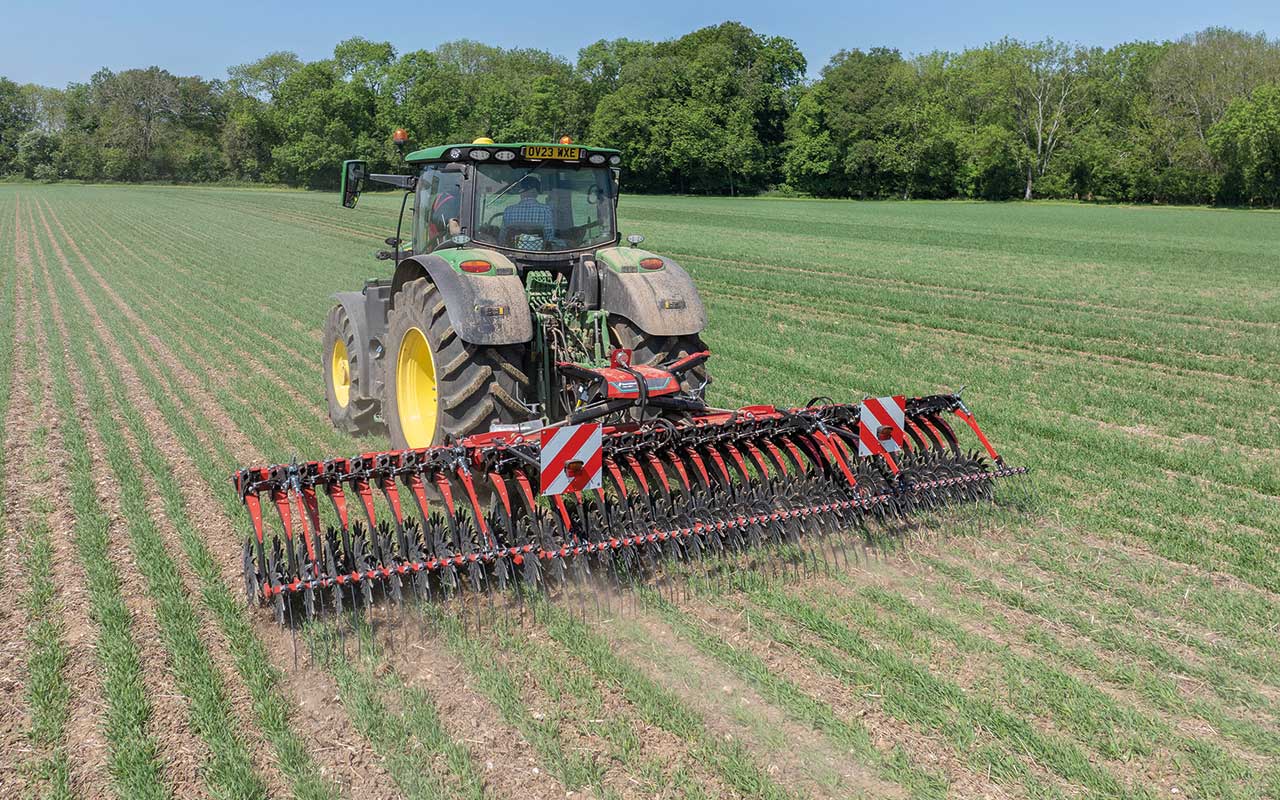
Kverneland
Kverneland’s mechanical weeding portfolio can be split into two ranges, with the Oynx hoeing series available in working widths from 2.84m up to 12.1m.
Row spacings down to 12.5cm can be handled with the machine, making it suitable for cereal crops, with a mechanical or hydraulically controlled parallelogram for individual row control.
Only the smallest models are available without a guidance system, with most of the range supplied with the Lynx integrated linkage.
This can be linked to up to two Tillett and Hague camera systems, as well as Isobus control, for lever or automated adjustment to minimise crop damage.
A feeler system can also be fitted, which follows the row crop and can take over the guidance when the crop canopy blocks the camera.
The company also offers the Helios rotary hoe, with 3m and 6m working widths and a choice of mechanical or hydraulic adjustment.
Isobus controls enable section control to be used in awkward-shaped fields, and a following harrow can be mounted at the rear to pull weeds away from the soil to bake in the sun.
Up to 72 star wheels are fitted, depending on the working width, and the company claims effective weeding can be done at 15kph.
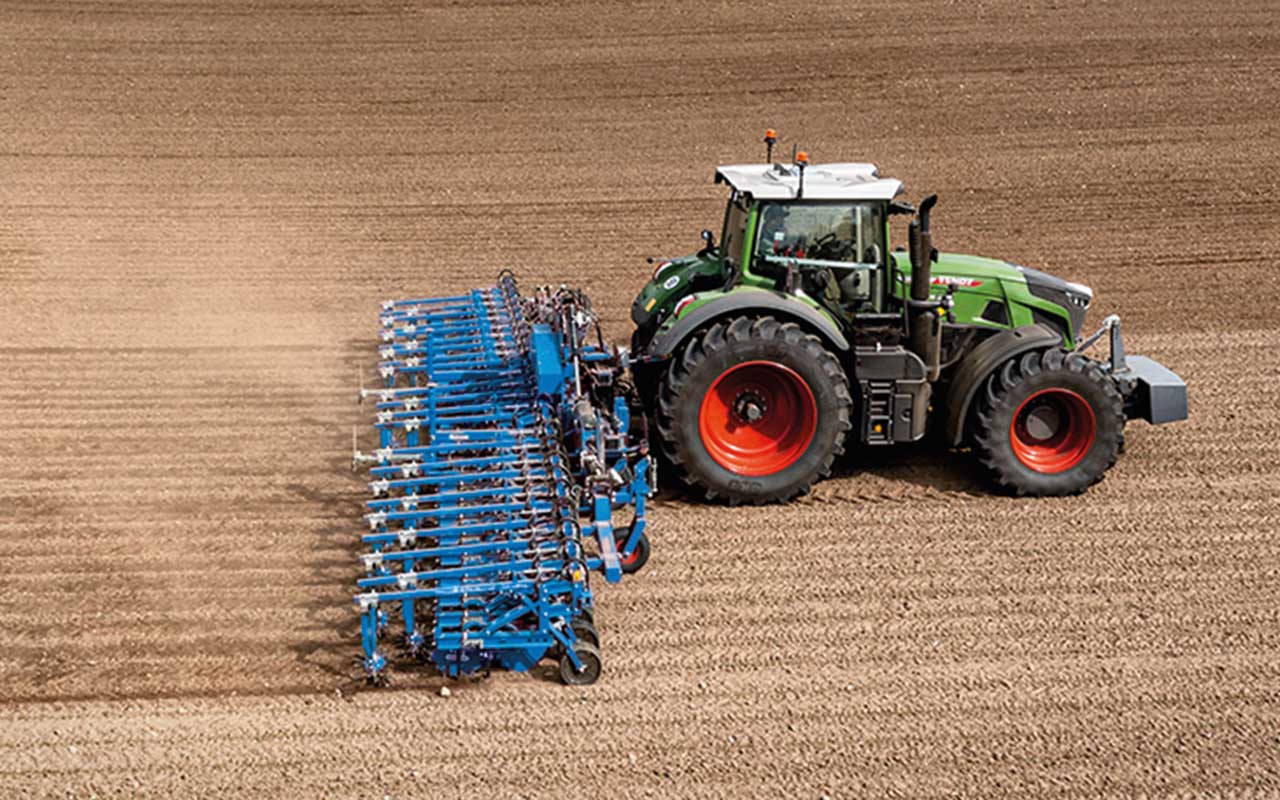
Lemken
The Thulit weed harrow is said to enable the early use of mechanical weed control. The OptiTine hydraulic tine pressure adjustment enables pressures to be continuously adjusted from the tractor cab from 0.1kg to a maximum contact force of 5kg/tine.
The indirect loading of the harrow tines ensures constant pressure with every tine position or angle, both on flat surfaces and when working in ridge crops.
The company’s EC-Weeder hoeing unit offers spacing from 15cm to 150cm, with working widths up to 13m.
The basic configuration consists of a frame, support wheels and hoeing elements, which can be adapted to the respective crops and soil conditions using a wide range of tools.
All variants are available as a base frame or with an integrated steering frame (V-version). The V-versions offer the option of control via joystick, row switch or camera.
The IC-Light automatic camera control system can work night or day, according to the company, with each camera recognising up to five rows to facilitate hoeing as close as 2cm to the cash crop, while still retaining a working speed of up to 15kph.
The EC-Weeder can be individually equipped with hoeing elements and tools to suit the site, with SprayHub and SprayKit options available for band spraying or fertilising.
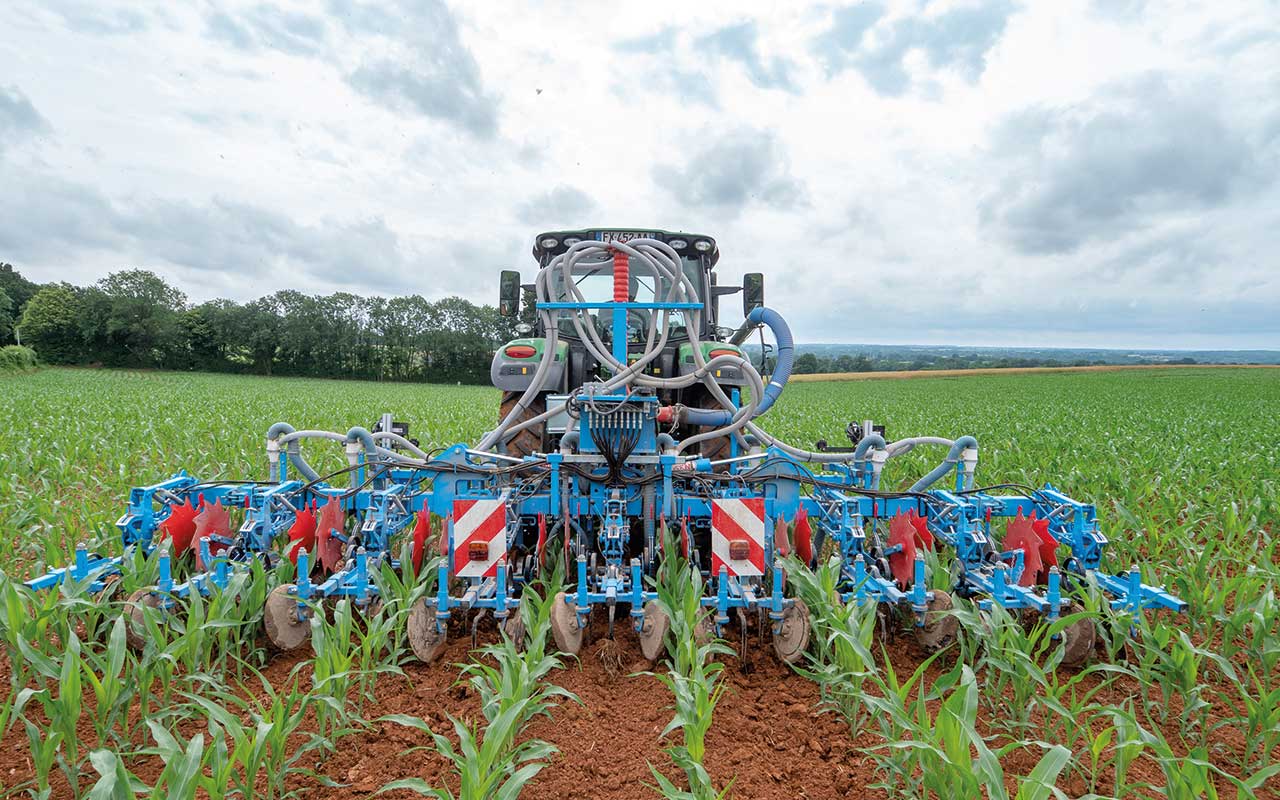
Monosem
Monosem’s latest inter-row cultivator is the Multicrop, said to be the heaviest-duty machine of its kind, available in working widths up to 8.9m, with up to 18 rows spaced from 45cm up to 80cm to suit the crop.
A range of tools are available, including hoeing shares in various widths, rotary plant protectors, comb harrows and more, with the possibility to fit up to five working elements.
Options include hoppers for one-pass seeding or fertiliser applications, with capacities depending on the size of the cultivator. When fertiliser is specified, product can be placed down one side of the row ahead of the cultivator tines, which bury it.
Using Isobus, it is possible to use GPS section control for individual rows, while the full Monosem range can be fitted with a camera-guided steering system, enabling the machine to sideshift up to 150mm based on the feeds of either the Tillet and Hague or Claas camera systems.
Monosem also offers the Multicrop Compact, designed for use in narrower crop rows, such as in cereals and vegetable crops.
The Multicrop range tops out the Monosem portfolio, which also includes the more basic Supercrop machines.
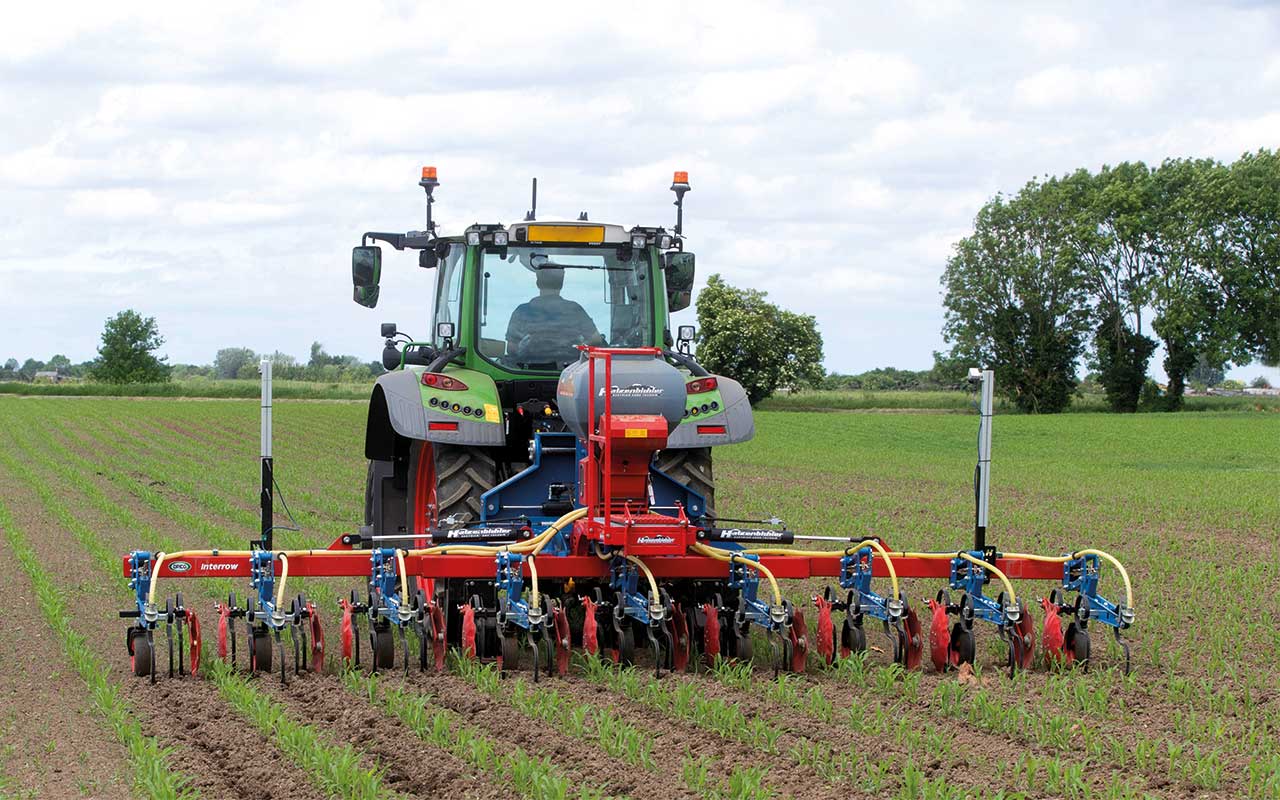
Opico
Opico’s comb harrow range features beds of tines that are designed to follow ground contours, equipped with six rows of adjustable 6mm or 7mm spring tines which can be adjusted and set at the required inclination. These are available in working widths of 1.5m to 27m.
This year, the company launched a new feature, enabling the operator to alter the angle attack of the tines without needing to leave the tractor cab, ensuring optimal efficiency as crop and soil conditions change across the field or throughout the day.
There is also a range of mechanical weeding solutions, including a series of inter-row cultivators and comb harrows from Austrian manufacturer Hatzenbichler, branded as Opico in the UK.
Opico inter-row cultivators are designed to accurately hoe between rows of growing crops to cut off weeds just below the surface to a minimum row spacing of 12.5cm.
Several shares are available, depending on row widths and crop types. Working widths range from 3m to 18m.
All models can be optioned with the Tillett and Hague single- or double-camera guidance system, integrated with the steering headstock to provide precise sideways movement up to 250mm in either direction.
With individual hydraulic cylinders on each parallelogram linkage, the Muller Isobus controller is able to lift individual row units as they reach previously cultivated ground.
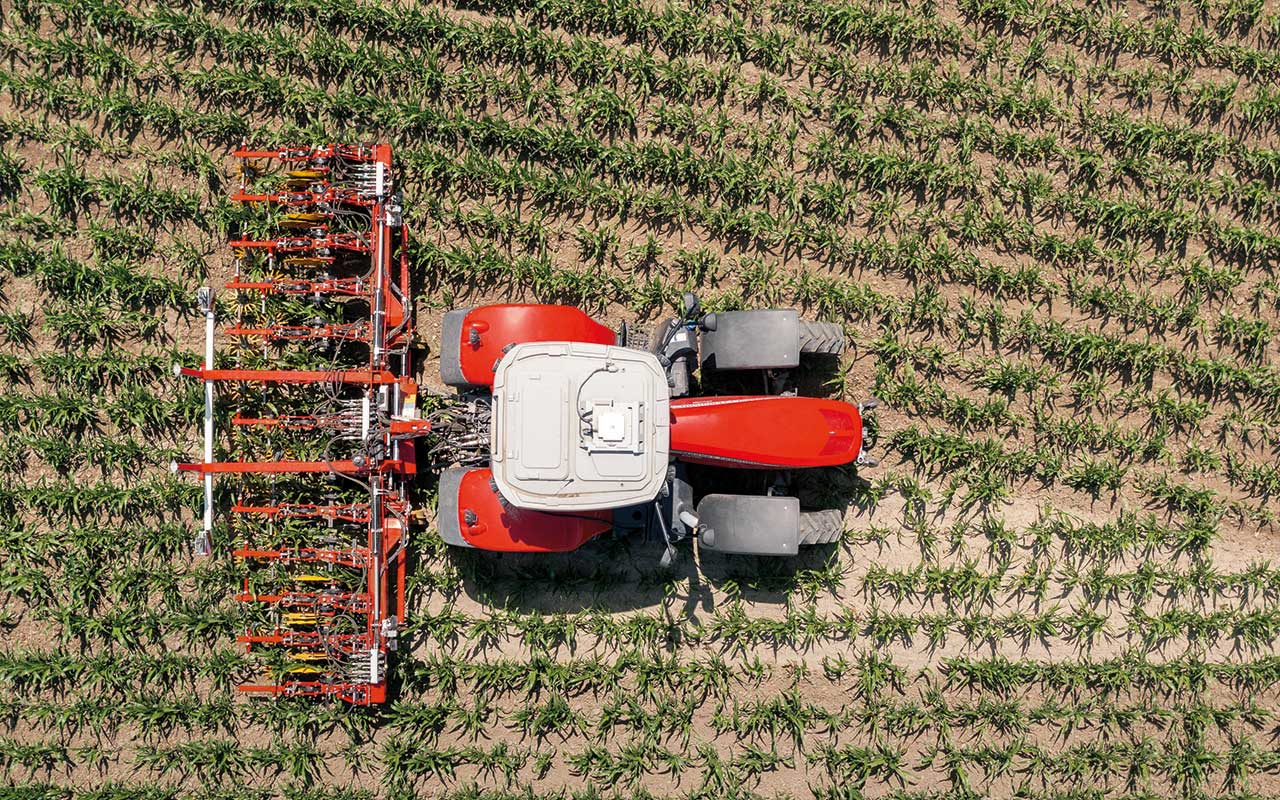
Pöttinger
The Rotocare and Flexcare mechanical weeders from Pöttinger have been updated with a host of new features.
These include the ability to mount a Tegosem hopper on the Rotocare V 6600 and V 8000 rotary hoes, as well as optional automatic hoe element section control on all Flexcare row crop cultivators with working widths of 4.7m to 9.2m.
The Tegosem hopper enables the sowing of a cover crop, microgranules or a companion crop in a single pass. To optimise the centre of gravity, it is mounted on the main frame with hopper capacities from 200 to 500 litres.
The Flexcare row crop cultivator features independent control of the finger hoeing units, row spacing, working width of the hoe elements and the correct position of the coulter. The machine features depth control in all operating conditions and crop-conserving operation.
The optional section control system raises and lowers the hoe elements using GPS. This happens automatically when the headland boundary is reached.
Each hoe element has a double-acting hydraulic cylinder to raise and lower according to GPS signals at the headland and in field corners.
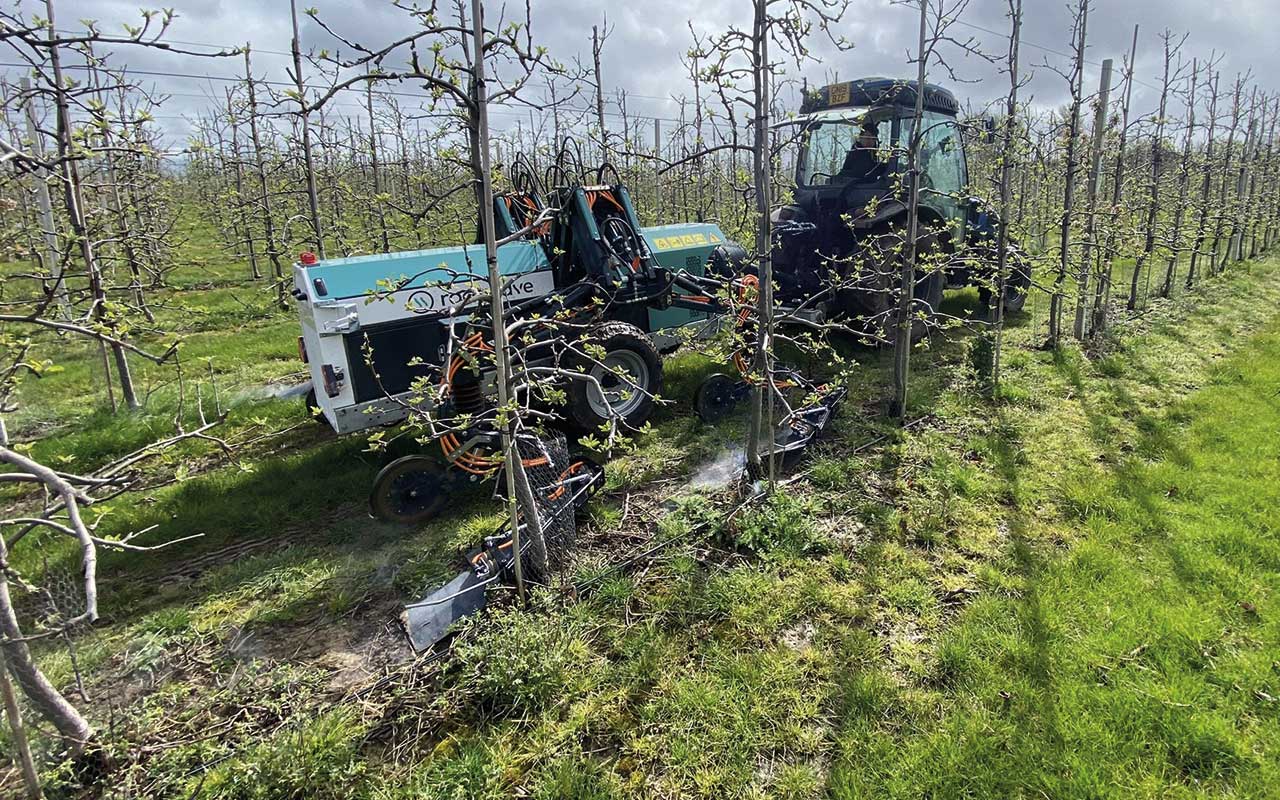
Rootwave
This novel machine from Rootwave uses a high-frequency alternating electrical current to destroy weeds. The company has partnered with Garford to bring this technology to broad-acre crops, but currently offers a trailed F601 eWeeder for use in vineyards and orchards.
By using electricity, weeds are boiled from the roots up, killing the plant and enabling the system to be used in all weed species.
Suitable for row widths from 1.8m to 4.5m, with a maximum working speed of 5kph depending on weed growth and density, the machine uses breakback arms that move between trees or vines, with a breakback function letting it move around the cash crop.
According to UK trials, the Rootwave system was capable of achieving a 99% reduction in weeds. The company further claims the use of electricity has not negatively affected soil-borne micro and macro fauna.
In fact, compared to herbicides, there are no restrictions on when the eWeeder can be used, regardless of wind, rain or timeliness in terms of harvest.
The company says when compared to inter-row cultivation or hoeing, the system does not disturb the soil, minimising the germination of additional weeds and helping to retain water and nutrients in the soil.
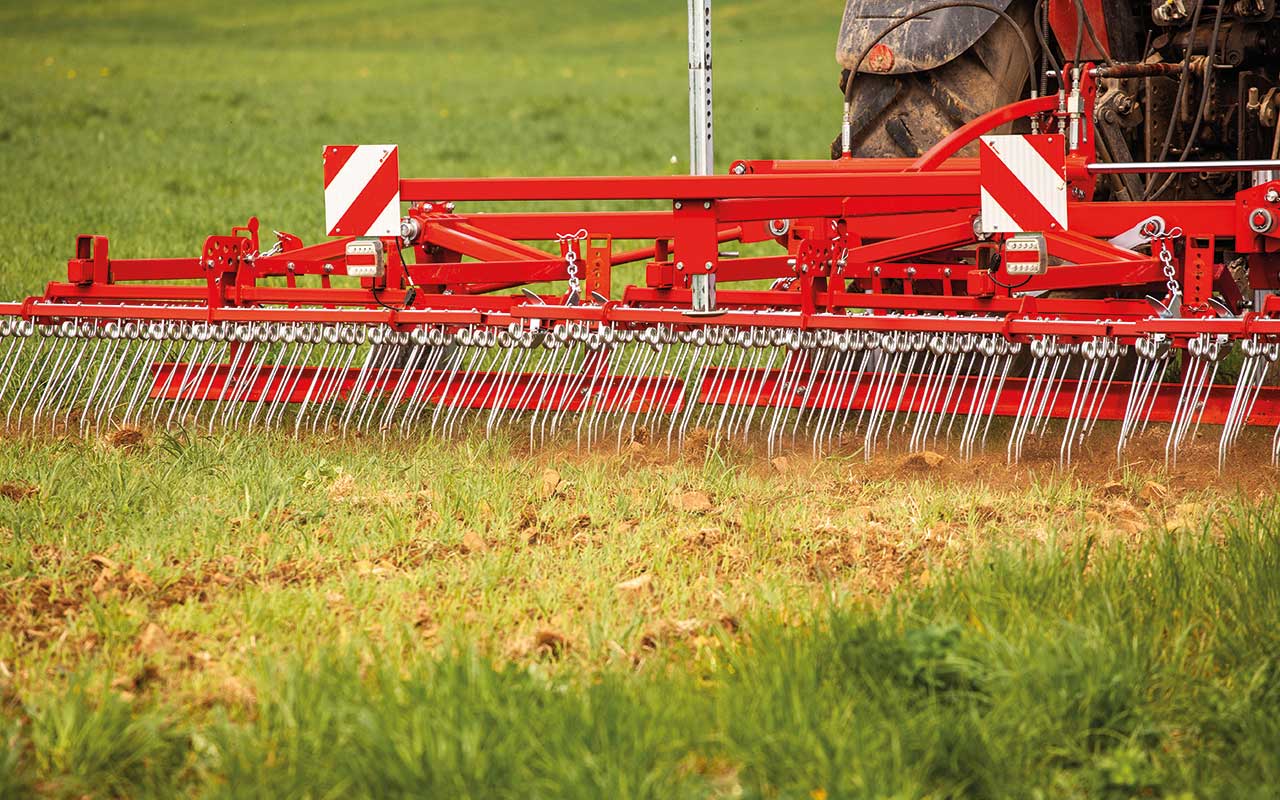
SMS Agro
Czech manufacturer SMS Agro is looking to break into the UK market with a portfolio of cultivation and grassland maintenance equipment.
The current offering includes the Lanio tine harrow. Suitable for grassland maintenance and arable applications, the tines are arranged in six rows spaced at 25mm.
The machine can be fitted with 6mm tines for vegetables, 7mm tines for work in cereals, or 8mm tines for grassland.
Working widths range from 2m to 12m, with single-frame versions or up to two-, three-, six-, and eight-frame configurations with hydraulic folding.
According to the company, the Lanio offers excellent contour following, both longitudinally and laterally, and is lightweight enough for use with low-horsepower tractors.
In cooperation with the Technologickou agenturou ČR and the Výzkumný ústav zemědělské techniky, SMS CZ is developing a unique robotic weeding machine with intelligent weed recognition.
This technology, scheduled for completion in 2026, will offer farmers precise mechanical weeding, not only between plant rows, but also within them. This will help minimise the use of herbicides and lead to improved soil protection.
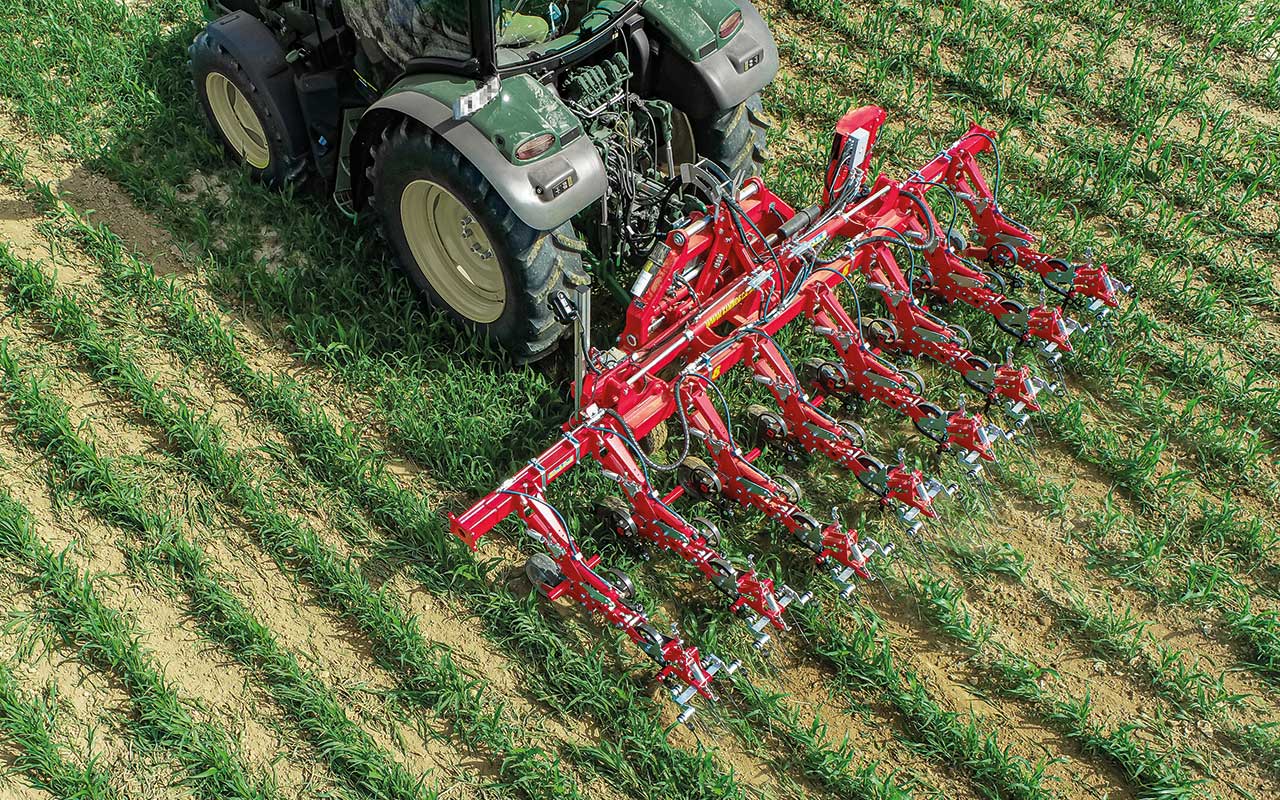
Terrington Machinery
Terrington Machinery is the UK importer for Einböck, providing one of the most extensive ranges on the market.
The Aerostar-Classic tined weeder is suitable for a range of crops. It is said to have the highest tine adjustment range on the market and enables blind weeding in addition to aggressive crust breaking.
As standard it comes equipped with 6.5x490mm or 7x 490mm tines with working widths up to 24m, and an underframe clearance of up to 49cm.
The Aerostar-Exact allows the user to uproot weeds from the soil at later stages of growth due to the 60cm clearance.
The Exact has a pendular axle with support wheels, increasing stability and depth control, making it suitable for delicate crops. It comes equipped with 7x600mm tines – perfect for sensitive crops.
Terrington also offers a rotary weeder with hydraulic adjustment and working widths up to 18m, while the Aerostar-Fusion is fully Isobus compatible and features hydraulic downward pressure of up to 6kg for the working elements.
The Chopstar hoeing range has a variety of configurations and specifications. The range begins with individually configurable hoeing units, suitable for most crops with row widths of 20-150cm.
Einböck hoes offer the option of one sweep per hoeing element up to five sweeps per hoeing element to ensure accurate and reliable results.
The Chopstar-Prime is the newest addition. It features an advanced quick-locking system, allowing the user to quickly adjust hoeing elements.
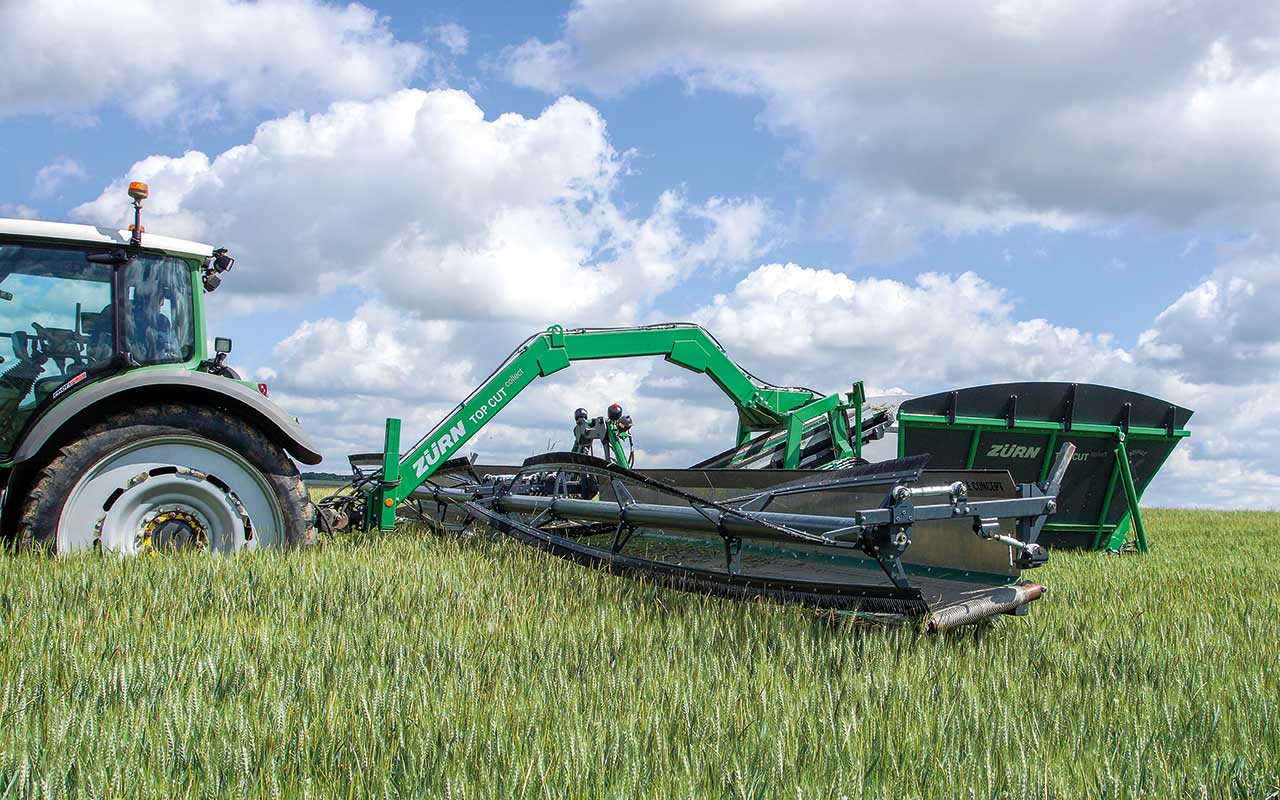
Zürn Harvesting
Rather than destroying weeds as they emerge, Zürn Harvesting has introduced products that will remove established weeds before they shed their seeds, gradually depleting the weed bank in the soil.
The Zürn Top Cut Collect cuts the seed heads of tall growing weed plants above the canopy of the standing crop and then collects the weed seeds in a hopper.
The trailed machine is available in working widths of 9m and 12m. Since introducing the weed harvester, Zürn has continued to refine the machine, with the latest updates including a brand-new operating system with a touchscreen display unit and a multifunction lever to handle folding and cutting height with one push.
If weeds survive through to harvest, the Seed Terminator is a simple attachment to the combine harvester that destroys weed seeds before they are spread out with the chaff. The efficacy of the Seed Terminator is proven by independent research organisations worldwide, including many parts of Europe.
It consists of two high-performance multi-stage hammer mills which process crop residue coming from the sieves. Flails and rotors push the material through multiple static screens to achieve a kill rate of up to 99%.
The latest evolution of the machine, the AeroIMPACT 4, comes with an increased throughput capacity and more compact design at the same time. This allows growers to equip even the most powerful John Deere X9 and Claas Lexion combines with a Seed Terminator.


